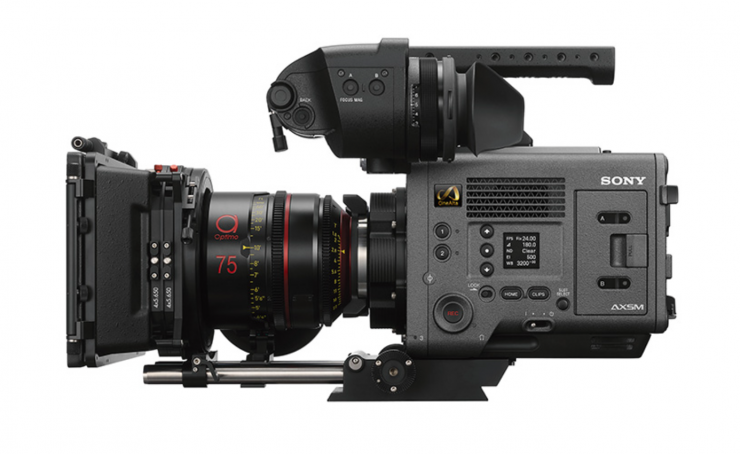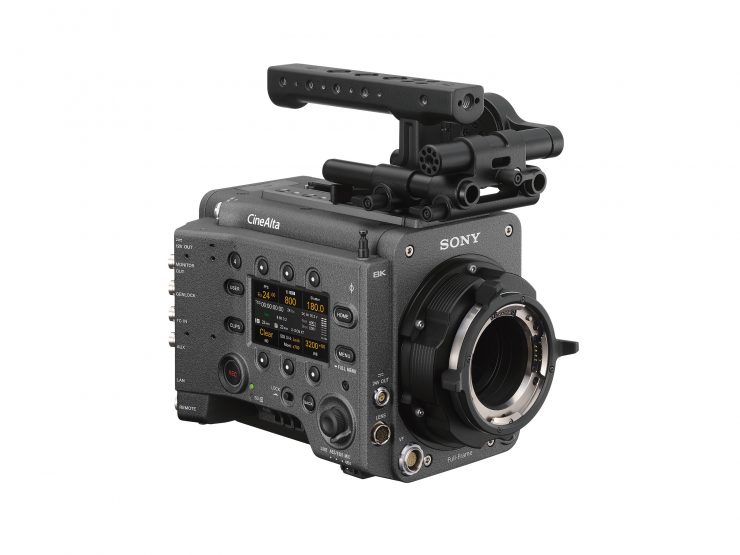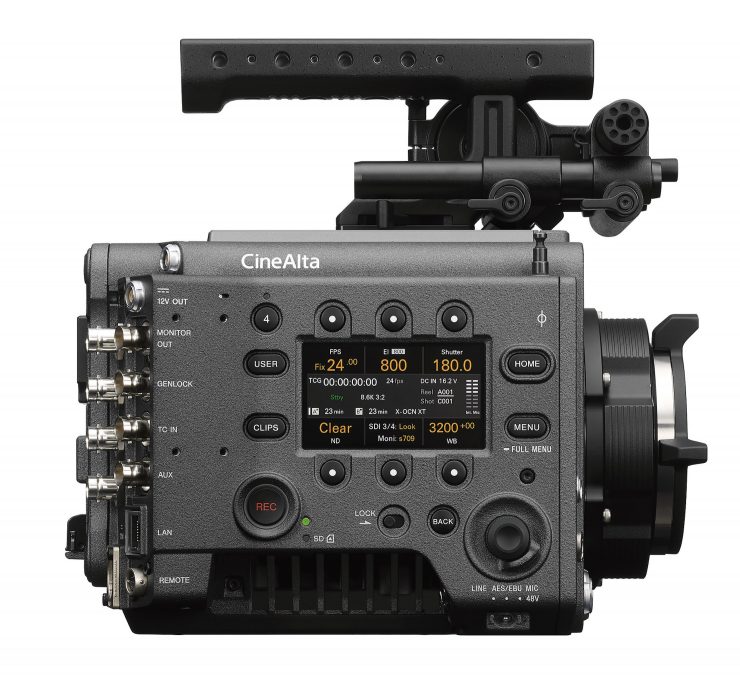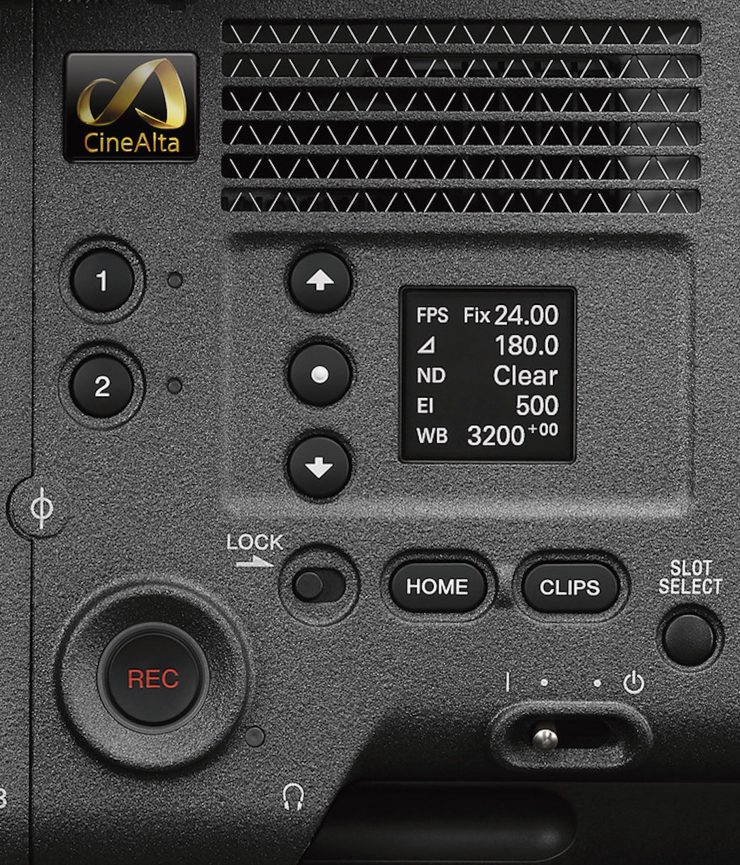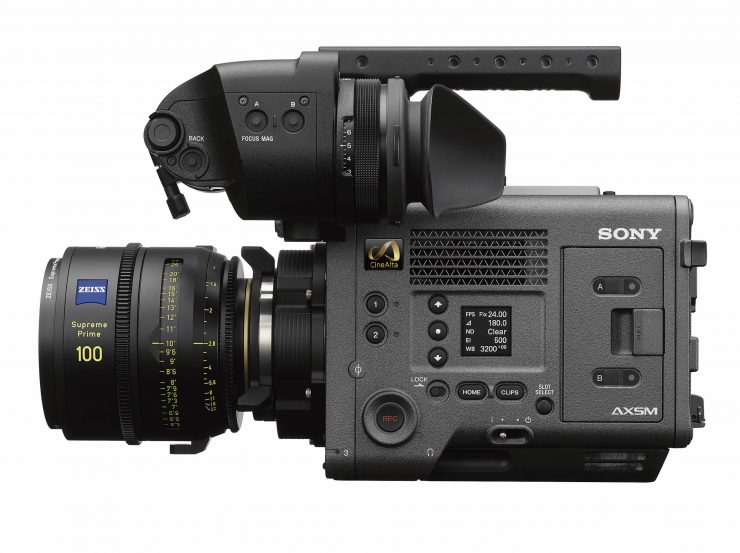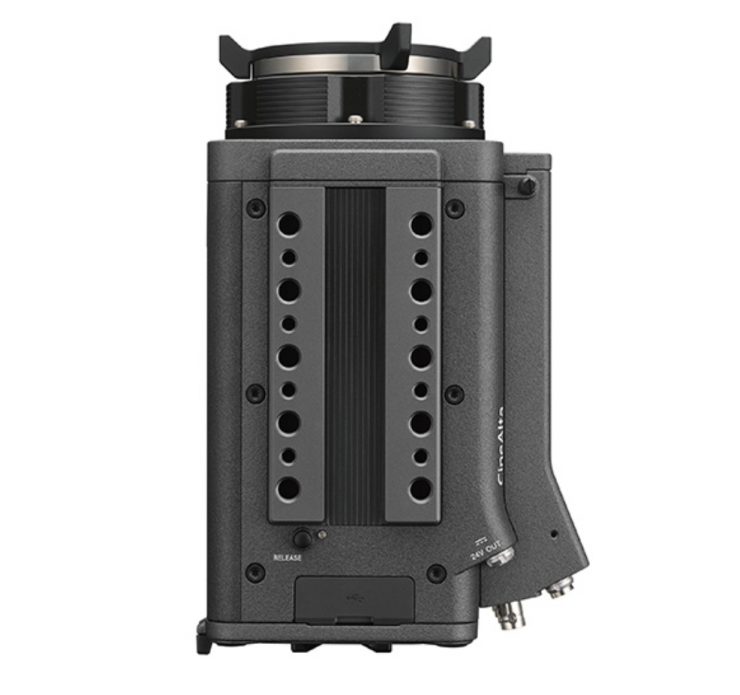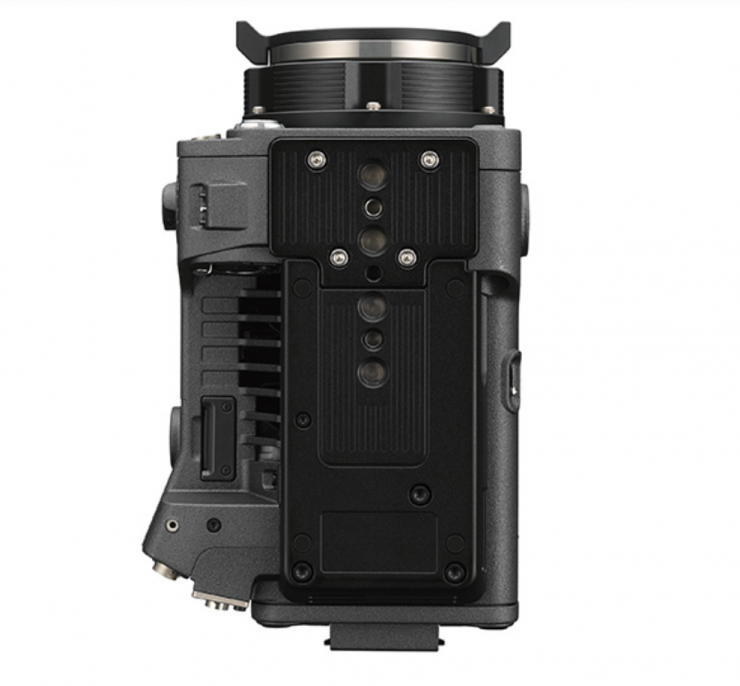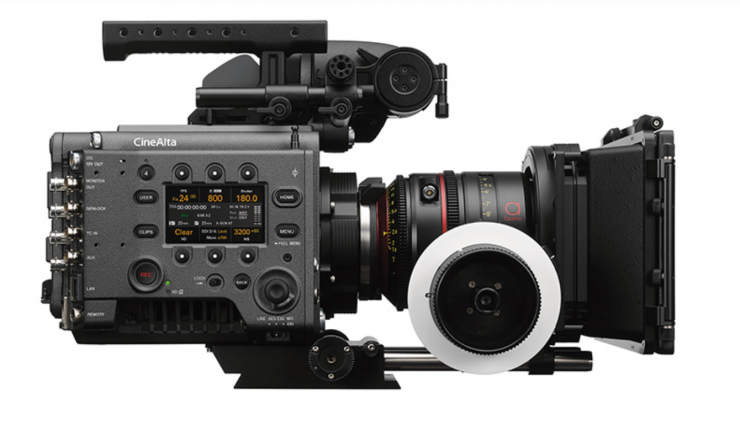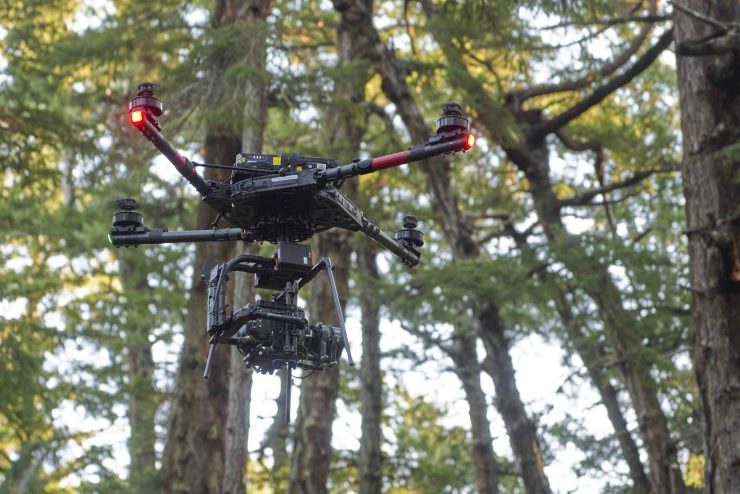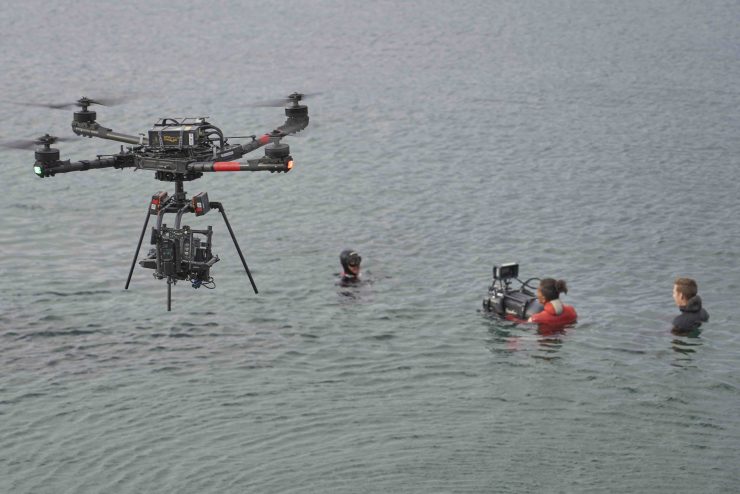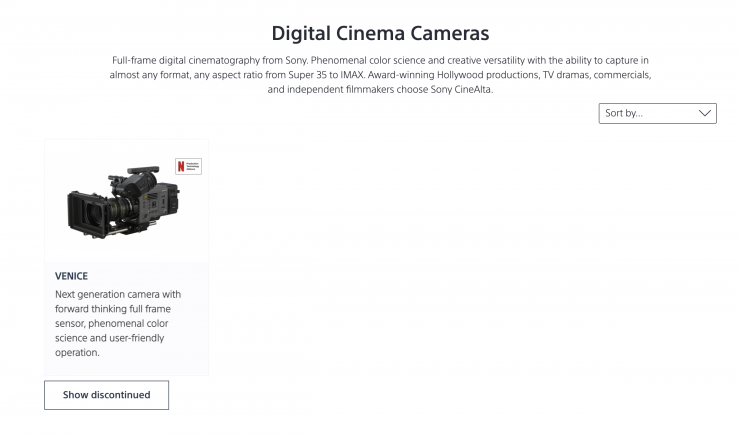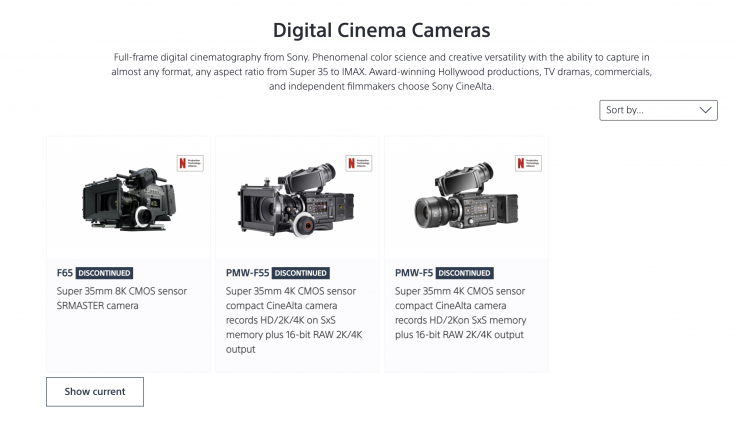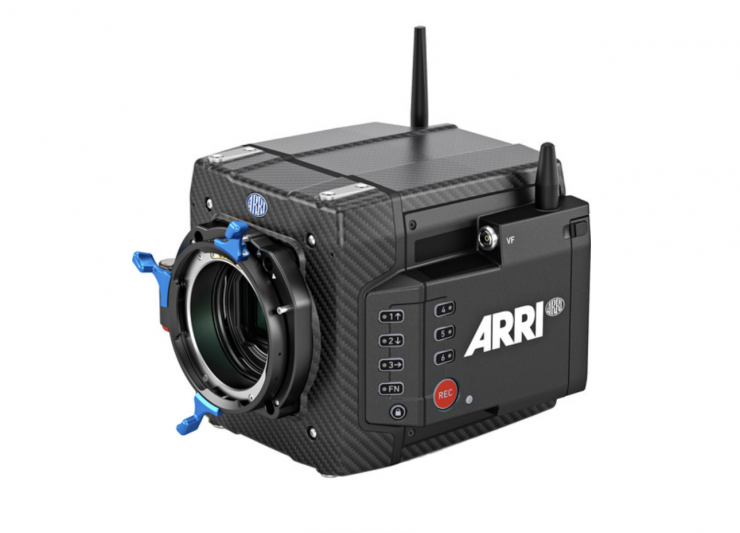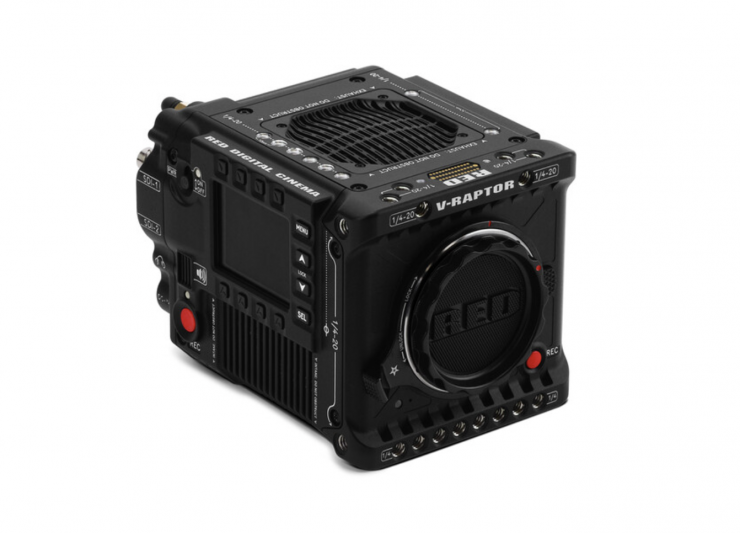Sony has announced the VENICE 2, an 8.6K full-frame camera that can record X-OCN RAW files internally, with a claimed dynamic range of 16 stops. The VENICE 2 will be available in two versions, one with an 8.6K full-frame sensor, and the other with a 6K sensor.
The VENICE was announced back in September 2017. It really doesn’t seem like that long ago, but four years in a long time as far as technological advances go.
What surprised me is that Sony has only been working on the VENICE 2 since the start of this year. This is not a camera that has been in development for many years, however, it does very much build on the existing VENICE platform.
Above you can watch the official Sony Livestream announcement of the VENICE 2.
Above you can watch “VENEZIA” that was shot by Rob Hardy, BSC, ASC.
Above you can watch the BTS of “VENEZIA”.
Above you can see Homecoming” that was shot by Rob McLachlan ACS, CSC on the VENICE 2 8K.
Above you can see a BTS video from “Homecoming” that was shot by Rob McLachlan ACS, CSC.
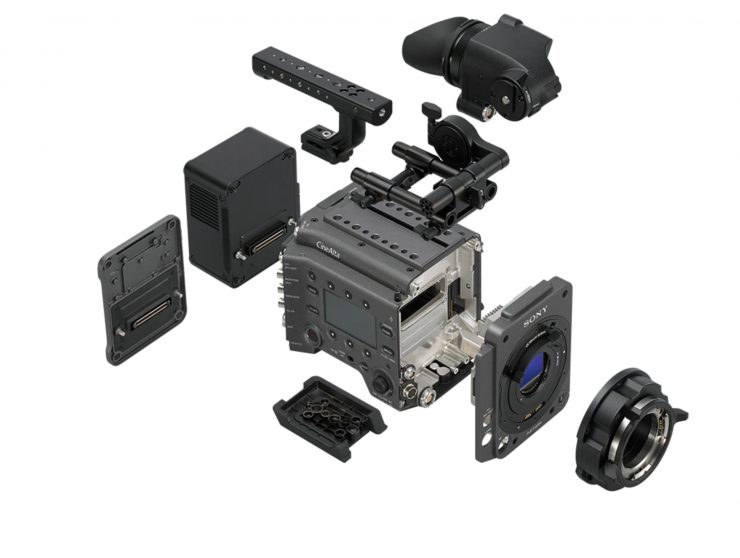
When Sony originally launched the VENICE they made a point to mention that it had been designed to be fully modular and even the sensor block was interchangeable. So, as sensor technology advanced in the far future, you would have the opportunity to upgrade without investing in a new camera.
This is a concept that has been mentioned for a long time. Remember RED’s whole sales pitch many years ago about being able to buy one camera body where you could upgrade the sensor as the years went on? I think the reality of actually being able to do this probably isn’t feasible, nor does it make a company as much money as selling someone a whole new camera.
In theory, being able to change over a sensor block makes a lot of sense, particularly in a high-end camera where someone is paying a lot of money. Nobody wants to buy a top-tier camera only for it to be superseded within a few years. However, the reality is that technology moves so quickly, that the hardware inside a camera and its recording capabilities won’t be compatible with newly designed sensors and new features. That is the exact scenario Sony has found itself in.
Sony hasn’t been able to deliver on its original promise that the VENICE would have the capability to have its sensor block swapped over. When I asked Sony about this they told me that originally when the VENICE was being developed the plan was that the sensor block could be swapped over, however, they managed to get higher frame rates and additional capabilities to work with the original sensor and therefore that somewhat negated the whole concept. There was a plan for a monochrome sensor, but that never came to fruition.
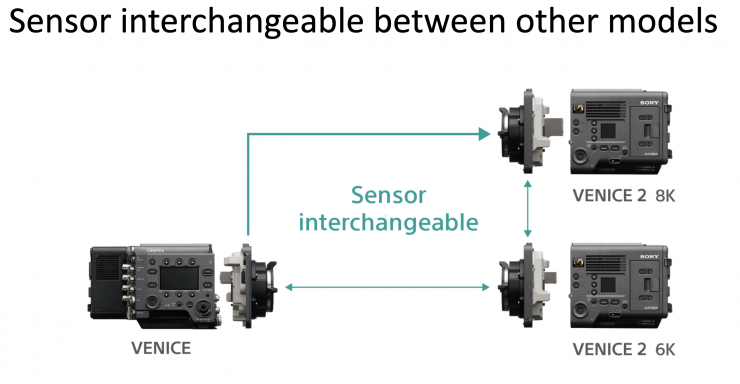
Now with the new VENICE 2, the sensor block swap is possible, but there are some caveats. The camera can be used with the 8.6K sensor as well as the original 6K sensor block. The camera body automatically recognizes the change and will start-up without any firmware exchanges or re-installs. The original 6K sensor will allow higher frame rates. Here is what you clearly need to know though. You can put the original 6K sensor (or the VENICE 2 6K sensor as they are identical) in the VENICE 2 8K. You can also put the VENICE 2 8K sensor in the VENICE 2 6K. What you can’t do is put the VENICE 2 8K sensor in the original VENICE.
As I already mentioned, placing the new 8.6K sensor in the original VENICE wasn’t really possible given the hardware constraints in the existing VENICE. Also, because Sony moved away from having to use an external recorder, the onboard recording capabilities wouldn’t have been possible with the current VENICE. The internal processing power just wasn’t up to the task of dealing with the increased resolutions and frame rates, and therefore, it needed to be re-engineered to do so.
To play the devil’s advocate for a second, companies really shouldn’t be mentioning upgrades and the swapping over of components in their sales pitch, because ultimately if they don’t take place you are selling consumers a pipe dream and not a reality. It isn’t all bad news for existing VENICE owners though. Sony told me that they will be offering trade-in deals for owners of the existing VENICE who want to upgrade.
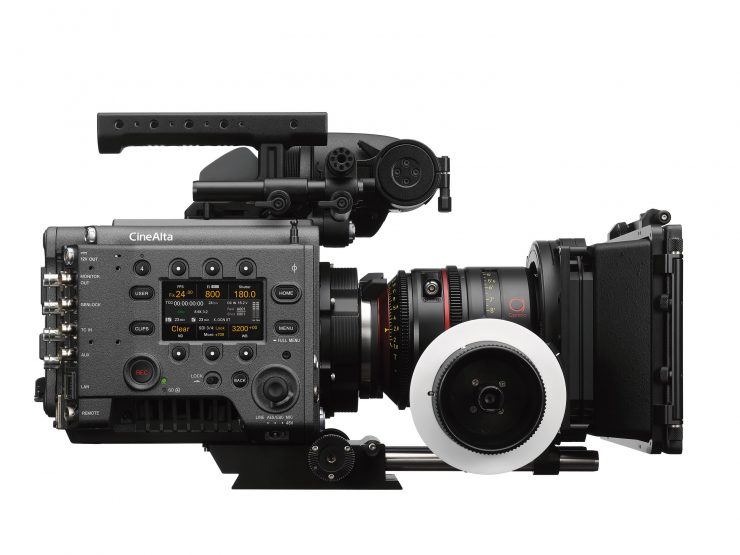
Key features
- 8.6K 3:2 Full Frame Sensor
- 8.6K 3:2 up to 30fps
- 8.2K 17:9/16:9 up to 60fps
- 5.8K up to 90fps (S35 crop)
- Dual Native ISO of 800/3200
- 16 stops of dynamic range (claimed)
- Internal X-OCN RAW recording
- Internal 4K ProRes recording
- An evolved product design based on VENICE
- Almost same I/O and screw holes for accessories
- Lots of updates based on VENICE users’ voices
- High speed 6.6Gbps AXS card for 8K 60p recording
- Image sensor interchangeable
Sensor
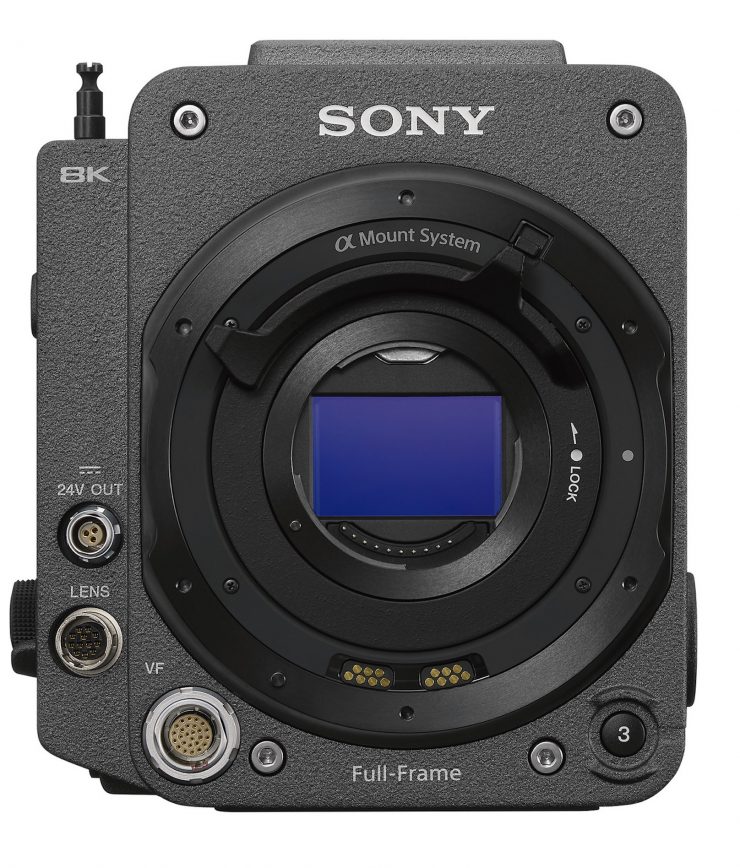
As I already mentioned, the VENICE 2 comes in two different versions. The 8K version comes with a completely new 8.6K (8640 x 5760) full-frame CMOS sensor that was developed especially for this camera. It is a 3:2 aspect ratio sensor with approx. 50MP. This new sensor has essentially doubled the amount of the MP that was found in the original VENICE.
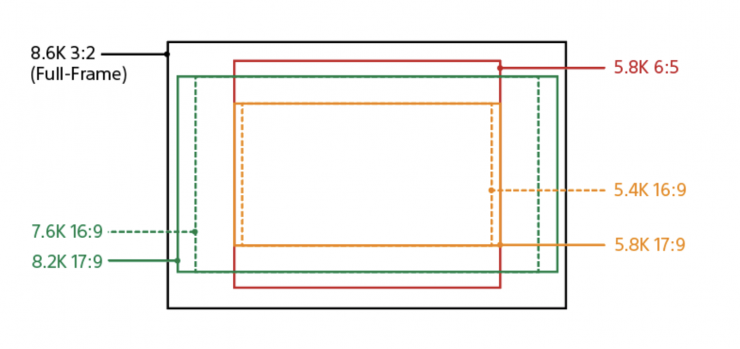
VENICE 2 8K 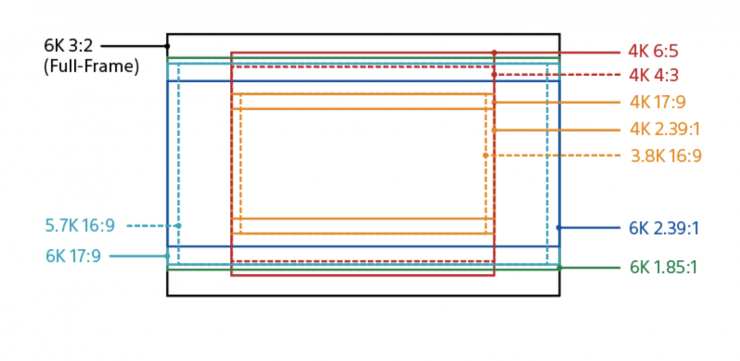
VENICE 2 6K
If you drop down to S35 mode the camera is utilizing a 5.8K area of the sensor.
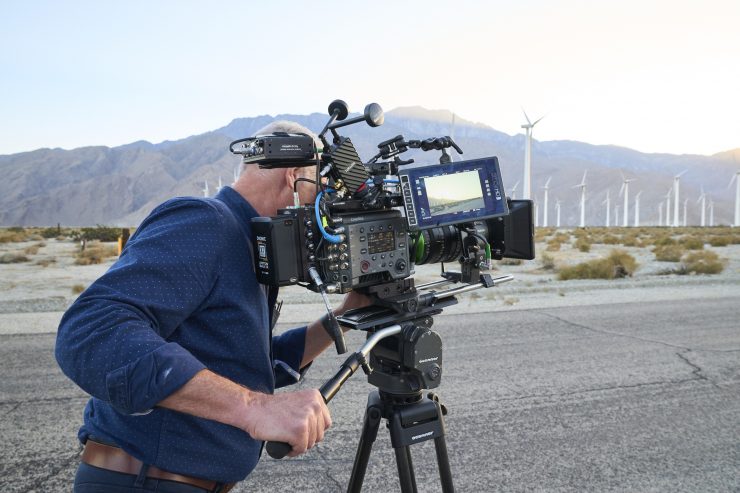
Sony is claiming that the VENICE 2 8K has 16 stops of dynamic range. Sony quoted 15+ stops with the original VENICE.
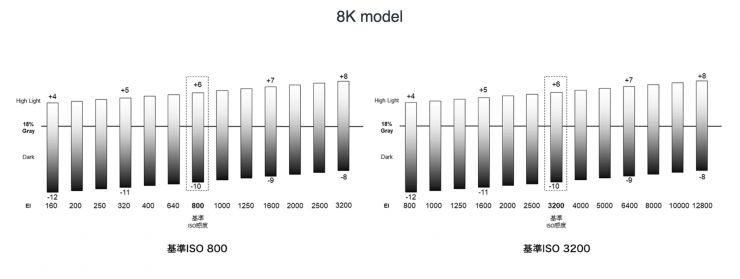
The latitude of the 8.6K sensor is based on 18% gray, with 6 stops above middle grey and 10 stops below. Essentially the VENICE 2 8K has the same amount of stops as the original VENICE when it comes to the highlights, but it gains a stop in the shadows.
What is interesting is that the Dual Base ISO’s on the VENICE 2 8K are now 800 and 3200 as opposed to the 500 and 2500 that were in the original VENICE. The VENICE 2 6K still maintains the 500 and 2500 Base Native ISO settings of the original.
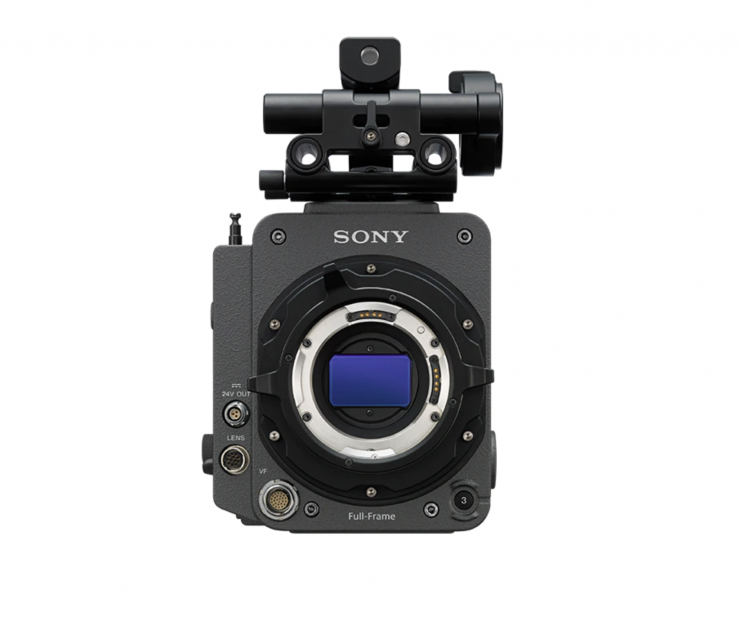
The 6K version of the VENICE 2 uses the same exact 36.2 x 24.1 mm (43.5 mm Diagonal) 24.8MP (total) sensor that is found in the original VENICE. All of the exact same resolutions and framerates that are available on the original VENICE will be available on the VENICE 2 6K.
Image quality is what Sony is pushing with the new VENICE 2 8K. Sony claims that the new VENICE 2 8K has less noise and is more sensitive in low light situations than the original.
Above you can listen to Claudio Miranda’s thoughts about using the new VENICE 2 8K.
While the VENICE 2 8K may look slightly different from the original it should still be very easy to match it with the original VENICE. The VENICE 2 6K will match perfectly with the old VENICE as both cameras are using the exact same sensor.
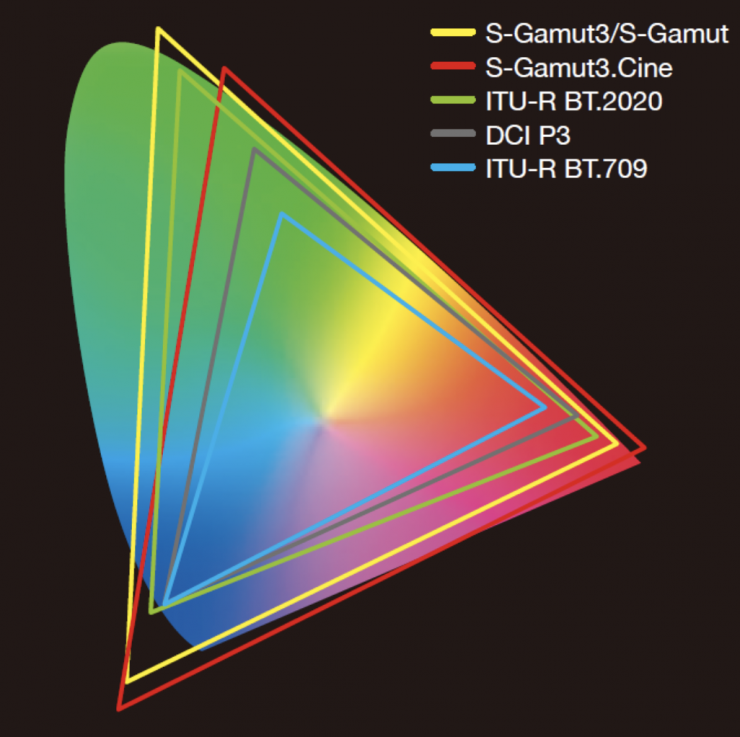
According to Sony, both cameras exceed the BT.2020 color space. The two image sensors are claimed to have the same color reproduction and they both utilize the same S-Gamut3 color space as the F55 and F65.
Recording Capabilities
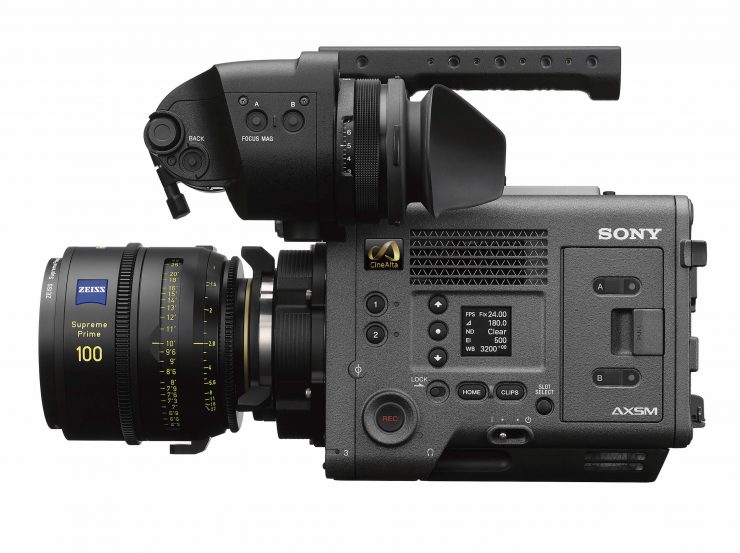
This is perhaps the biggest news. The VENICE 2 no longer requires the use of the AXS-R7 external recorder to be able to record X-OCN ST/LT or XT files. This is now all done internally to the camera’s dual AXS slots.
If you are not familiar X-OCN, it was introduced in 2016. X-OCN (extended tonal range Original Camera Negative) produces file sizes much smaller than typical camera RAW, but unlike conventional codecs, X-OCN offers 16-bit scene linear encoding.
X-OCN XT captures the highest quality imagery: it is ideal for demanding visual effects work and productions requiring the utmost image quality from VENICE. X-OCN XT profile maintains economical file sizes comparable to Sony’s RAW file size, making the workflow affordable and efficient. In comparing X-OCN with Sony’s RAW format, X-OCN has superior reproduction in low light areas and high light areas
X-OCN ST is recommended for most applications. It preserves the tremendous subtlety, image information, and processing robustness of 16-bit Scene Linear while optimizing file sizes for efficient workflow with 30% smaller file sizes than Sony RAW
X-OCN LT is ideal when you need even smaller file sizes. These files are 60% smaller than Sony RAW yet still give you the picture quality and image processing flexibility provided by a 16-bit Linear file.
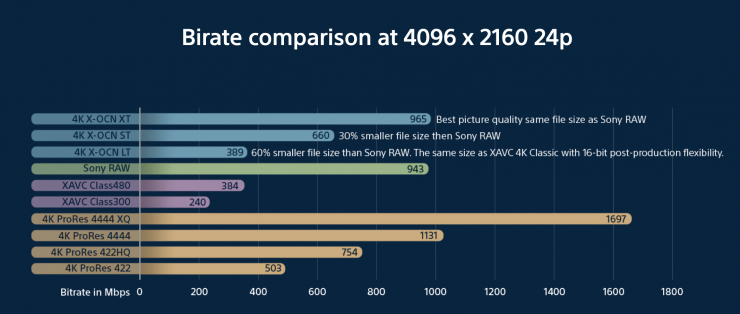
Above you can see a bitrate comparison between X-OCN, XAVC, and ProRes.
Speaking of ProRes, both cameras can also record 4K ProRes 422 HQ and ProRes 4444. A future firmware upgrade with add Prores 4444 XQ. You can’t record ProRes in any resolution higher than 4K.
It appears that Sony has removed the XAVC recording options from the VENICE 2 8K.
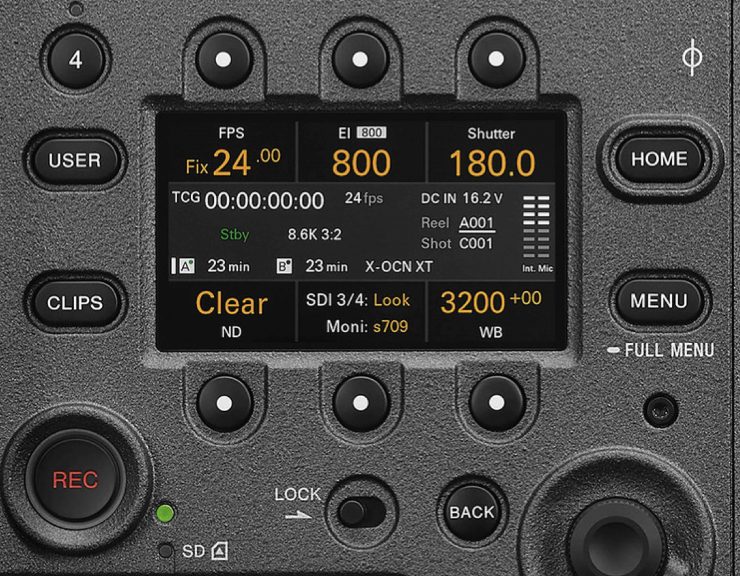
So how is Sony actually recoding a compressed RAW recording format internally given certain patents that exist? Given the fact that Nikon also recently announced a camera that can record a compressed RAW format internally there must be something going on behind the scenes that is now letting compressed RAW be recorded internally.
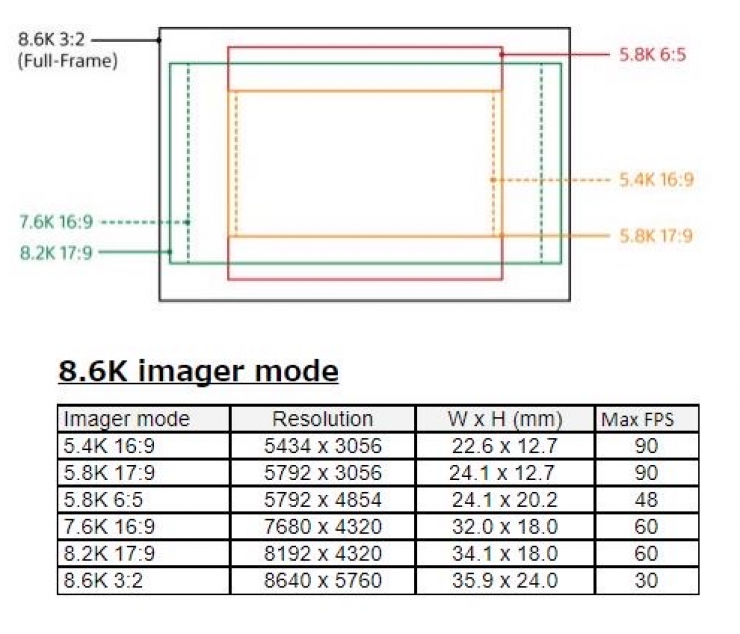
So what can the VENICE 2 8K actually record? The camera is capable of recording 8.6K 3:2 (8640 x 5760) in X-OCN up to 29.97p. In 17:9 it can record 8.2K (17:9) up to 59.94p. You can also do 7.6K 16:9 up to 59.94p.
If you drop down to an S35 recording mode you can record 5.8K 6:5 (5792 x 4854) at up to 49p. In 5.8K 16:9 or 17:9 you can go up to 90p.
There are currently no 4K recording options at all on the VENICE 2 8K at launch. In the future, they will be implemented, but they will be done with an additional sensor crop (around 17mm x 9mm of the sensor will be used) that will be somewhere between S35 and S16. In theory, this crop should be able to support quite high frame rates. This should be implemented when the Version 2.0 firmware gets released.
According to Sony Japan, VENICE 2 will be capable of HFR shooting at 4K up to 120fps.
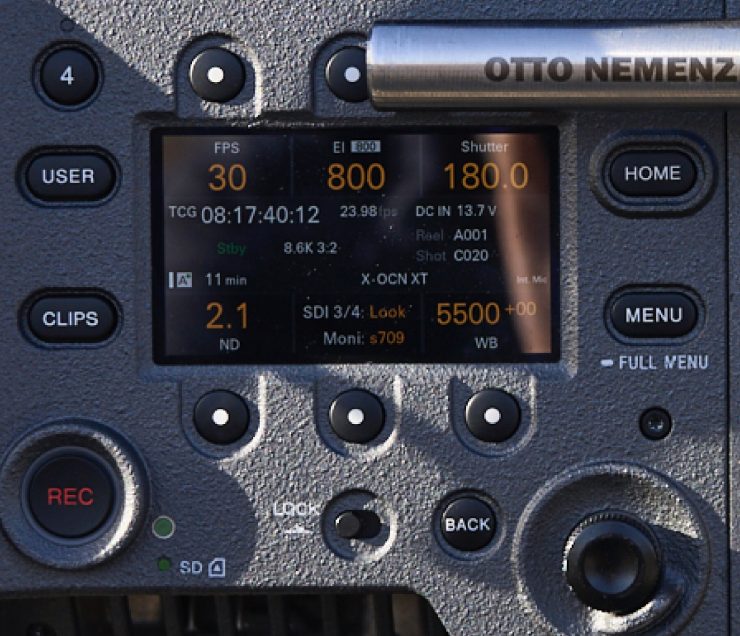
The frame rates and resolutions of the VENICE 2 8K are fairly substantial bumps over the resolutions and frame rates that were available in the original VENICE. What you need to remember carefully, is the VENICE 2, just like the original VENICE, does require additional paid licenses to unlock certain features. With the VENICE 2, high frame rates no longer require a license, but to get access to full-frame recording and anamorphic shooting modes still requires you to pay extra for licenses.
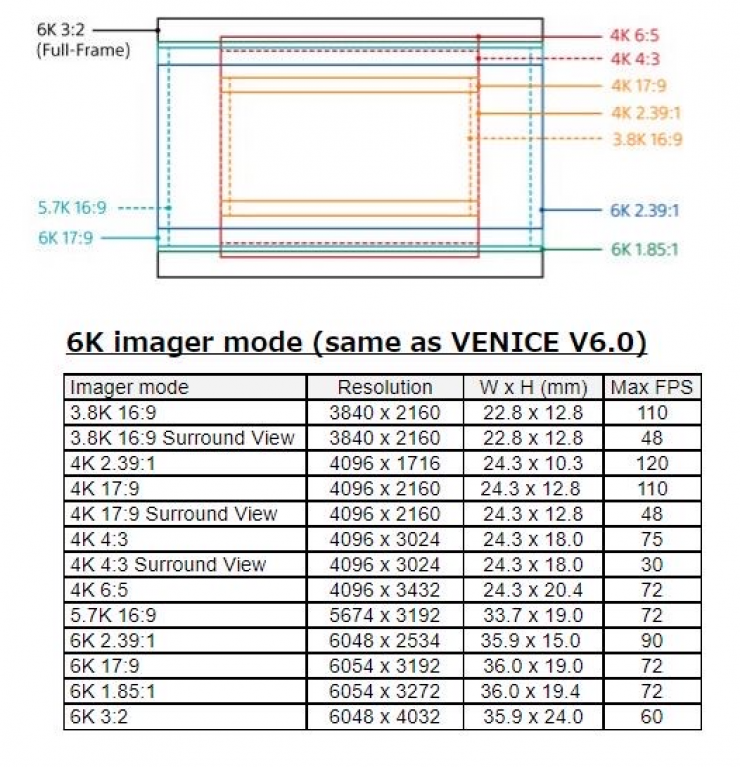
Above you can see the recording resolutions and framerates of the Venice 2 6K, which are exactly the same as the current VENICE running version 6 firmware.
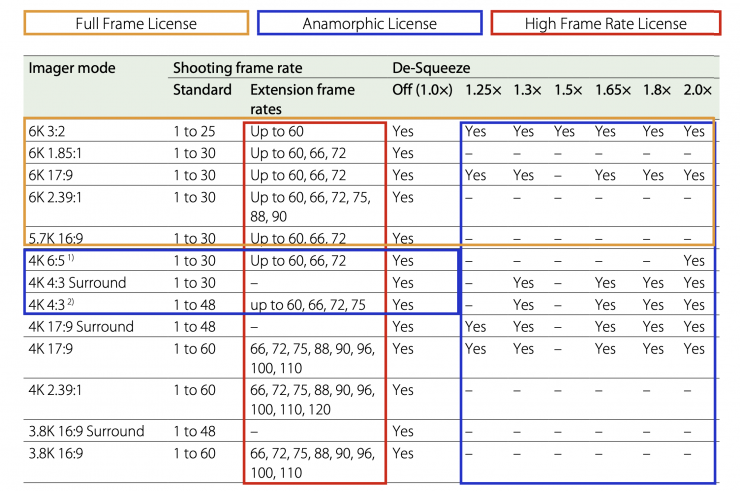
Above you can see what the current capabilities of the VENICE are in terms of frame rates, resolutions, and recording modes when it comes to licenses. With the original VENICE, you were limited to 4K at up to 59.94p if you didn’t buy any of the licenses. With the VENICE 2 8K even if you don’t buy the full-frame license you can still shoot at up to 5.8K at 90fps. It is also important to remember that you can now record X-OCN and ProRes internally without the need for the eternal AXS-R7 recorder.
The paid licenses structure gets very complicated with VENICE. I really wish they would do away with the whole license thing and just have one base model, especially since there is now a VENICE 2 6K as well.
Look, I get it, having licenses made sense when there was only one VENICE, but now there are three, so Sony should be able to tier them appropriately so that there is no need for licenses anymore.
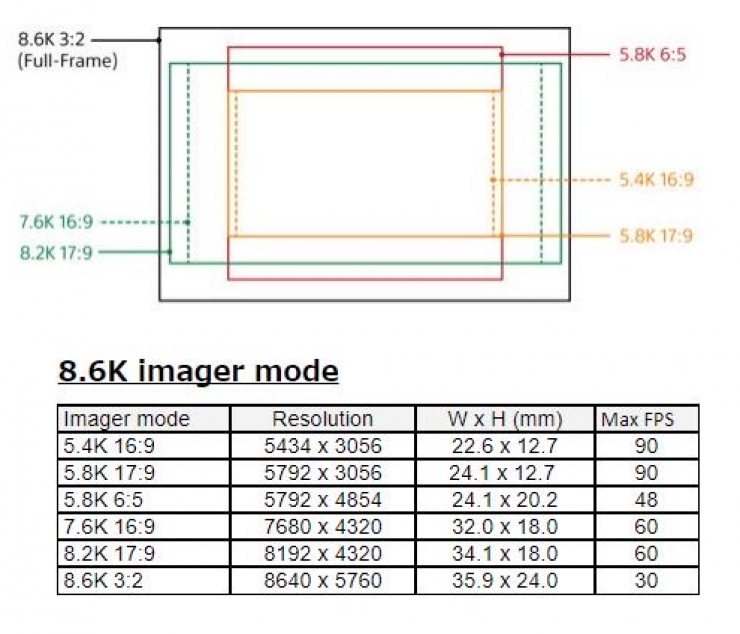
VENICE 2 8K
Recording Format (X-OCN ST/LT)
- 8.6K (8640 x 5760) 3:2 (full frame): 23.98p, 24p, 25p, 29.97p
- 8.6K 8192 x 4320) 17:9 (full frame) 23.98p, 24p, 25p, 29.97p, 50p, 59.94p
- 7.6K (7680 x 4320) 16:9 (full frame) 23.98p, 24p, 25p, 29.97p, 50p, 59.94p
- 5.8K (5792 x 4854) 6:5 Anamorphic (S35): 23.98p, 24p, 25p, 29.97p, 48p
- 5.8K (5792 x 3056) 17:9 (S35): 23.98p, 24p, 25p, 29.97p, 50p, 59.94p, 72p, 90p
- 5.8K (5452 x 3056) 17:9 (S35): 23.98p, 24p, 25p, 29.97p, 50p, 59.94p, 72p, 90p
Recording Format (X-OCN XT)
- 8.6K (8640 x 5760) 3:2 (full frame): 23.98p, 24p, 25p, 29.97p
- 8.6K 8192 x 4320) 17:9 (full frame) 23.98p, 24p, 25p, 29.97p, 50p, 59.94p
- 7.6K (7680 x 4320) 16:9 (full frame) 23.98p, 24p, 25p, 29.97p, 50p, 59.94p
- 5.8K (5792 x 4854) 6:5 Anamorphic (S35): 23.98p, 24p, 25p, 29.97p, 48p
- 5.8K (5792 x 3056) 17:9 (S35): 23.98p, 24p, 25p, 29.97p, 50p, 59.94p, 72p, 90p
- 5.8K (5452 x 3056) 17:9 (S35): 23.98p, 24p, 25p, 29.97p, 50p, 59.94p, 72p, 90p
VENICE 2 6K
Recording Format (X-OCN ST/LT)
- 6K 3:2 (6048 x 4032): 23.98p, 24p, 25p, 29.97p, 50p, 59.94p
- 6K 2.39:1 (6048 x 2534): 23.98p, 24p, 25p, 29.97p, 50p, 59.94p, 90fps
- 6K 1.85:1 (6054 x 3272): 23.98p, 24p, 25p, 29.97p, 50p, 59.94p
- 6K 17:9 (6054 x 3192): 23.98p, 24p, 25p, 29.97p, 50p, 59.94p, 72fpp
- 5.7K 16:9 (5674 x 3192): 23.98p, 24p, 25p, 29.97p, 50p, 59.94p, 72fps
- 4K 6:5 (4096 x 3432): 23.98p, 24p, 25p, 29.97p, 50p, 59.94p
- 4K 4:3 (4096 x 3024): 23.98p, 24p, 25p, 29.97p, 50p, 59.94p
- 4K 17:9 (4096 x 2160): 23.98p, 24p, 25p, 29.97p, 50p, 59.94p
- 4K 2.39:1: 23.98p, 24p, 25p, 29.97p, 50p, 59.94p
- 3.8K 16:9 (3840 x 2160): 23.98p, 24p, 25p, 29.97p, 50p, 59.94p
Recording Format (X-OCN XT)
- 6K 3:2 (6048 x 4032): 23.98p, 24p, 25p, 29.97p
- 6K 2.39:1 (6048 x 2534): 23.98p, 24p, 25p, 29.97p, 50p, 59.94p, 90fps
- 6K 1.85:1 (6054 x 3272): 23.98p, 24p, 25p, 29.97p, 50p
- 6K 17:9 (6054 x 3192): 23.98p, 24p, 25p, 29.97p, 50p, 59.94p, 72fps
- 5.7K 16:9 (5674 x 3192): 23.98p, 24p, 25p, 29.97p, 50p, 59.94p,72fps
- 4K 6:5 (4096 x 3432): 23.98p, 24p, 25p, 29.97p, 50p, 59.94p
- 4K 4:3 (4096 x 3024): 23.98p, 24p, 25p, 29.97p, 50p, 59.94p
- 4K 17:9 (4096 x 2160): 23.98p, 24p, 25p, 29.97p, 50p, 59.94p
- 4K 2.39:1: 23.98p, 24p, 25p, 29.97p, 50p, 59.94p
- 3.8K 16:9 (3840 x 2160): 23.98p, 24p, 25p, 29.97p, 50p, 59.94p
Recording Format (RAW SQ)
- 4K 17:9 (4096 x 2160): 23.98p, 24p, 25p, 29.97p, 50p, 59.94p
- 3.8K 16:9 (3840 x 2160): 23.98p, 24p, 25p, 29.97p, 50p, 59.94p
Recording Media
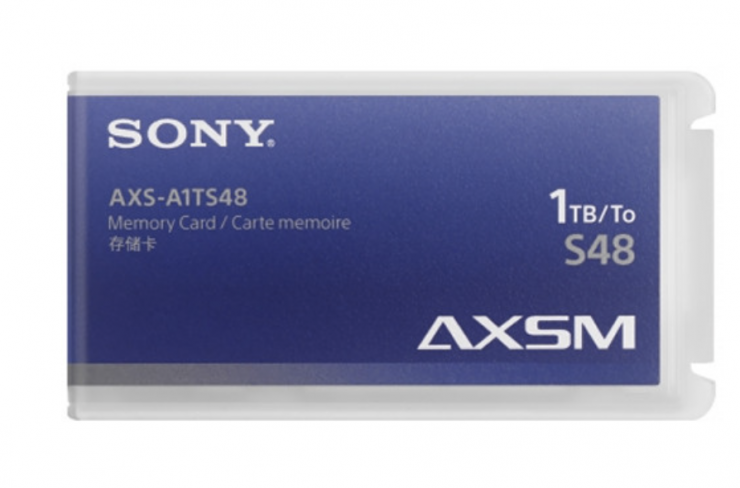
Gone are the dual SxS slots that were in the original VENICE. These have been replaced by AXS memory card slots. These are located in the exact same place as where the SxS card slots are on the original VENICE.
SxS cards simply wouldn’t have been fast enough to record the data rates required for X-OCN files. It made sense for Sony to go with the same type of media they had already developed for the AXS-R5 and AXS-R7 recorders. The original AXS media cards have a maximum write speed of 4.8 Gb/s.
These cards weren’t cheap. A single 1TB AXS Memory A-Series Card costs a whopping $4,500 USD. Now, it is important to note that Sony is actually introducing a new 1TB AXS Memory A-Series Card called an S66, the older card is an S48. While the capacity is still 1TB the maximum write speed has jumped up to 6.6 Gb/s as opposed to the 4.8 Gb/s of the S48 card.
I am still trying to find out if the older AXS card will work with the new camera. I do know that existing AXS Memory Card Readers including the AXS-AR3 via Thunderbolt3 interface are compatible with the new media.
Form Factor
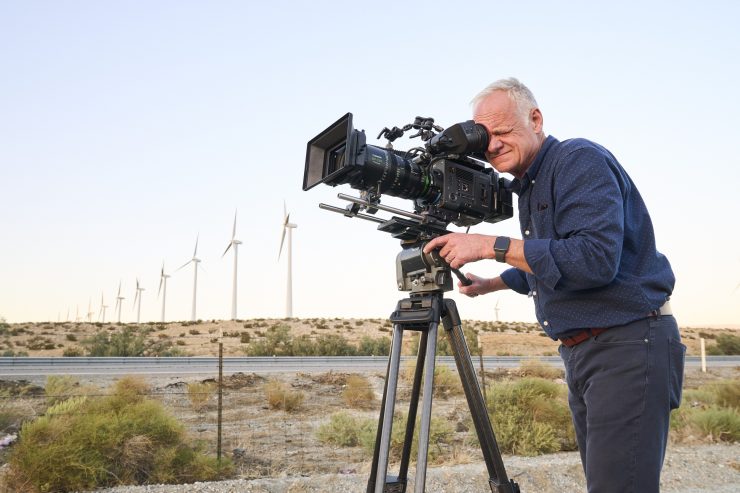
The VENICE 2 is roughly the same size and weight as the original VENICE. The VENICE 2 is 15mm longer than the original VENICE, however, it is actually 44mm shorter because you don’t have to attach the AXS-R7 recorder.
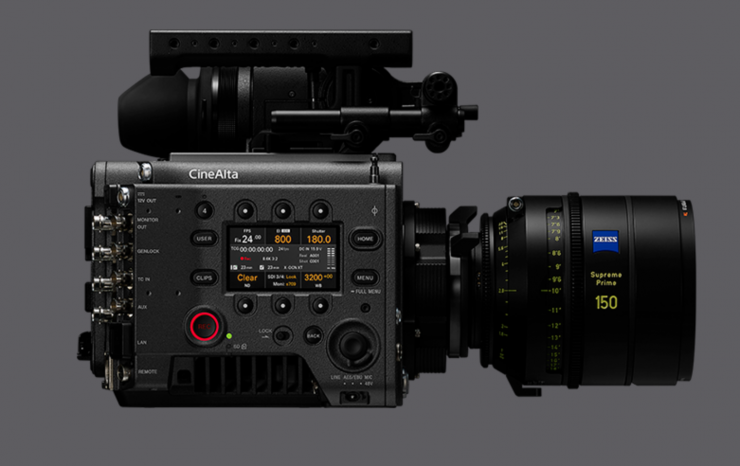
In terms of weight, the VENICE 2 8K tips the scales at 4.2Kg / 9.25lb. The VENICE 2 6K weighs 4.1kg / 9.03 lb. As a reference, the original VENICE weighs 3.9kg / 8.59lb.
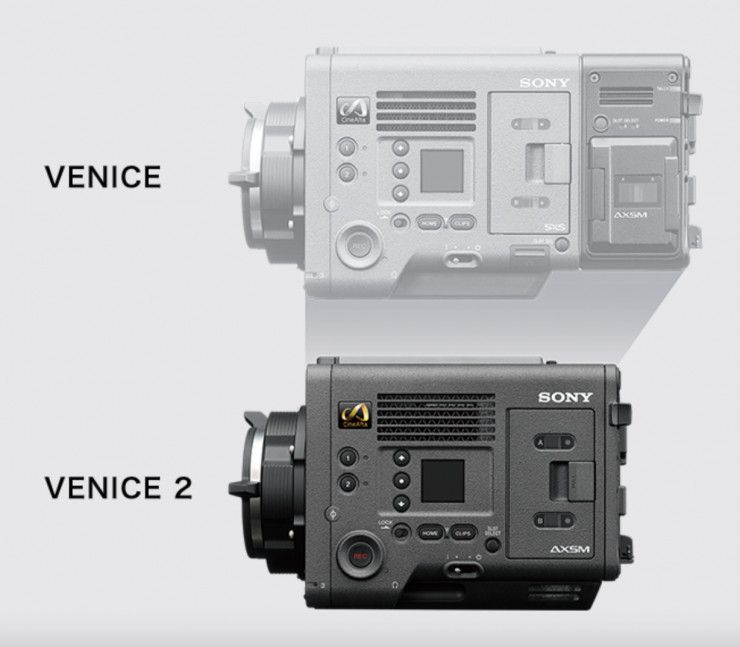
Above you can see the difference in size between the original VENICE with the AXS-7 recorder attached and the new VENICE 2.
Ergonomically, with the removal of the AXS-R7, you are now making the camera slightly more compact, and most importantly, more self-contained. This allows it to be easily used in an underwater housing, on drones, etc.
Keeping the same form factor means that all of the third-party accessories that work on the original VENICE will work on the VENICE 2, with the exception of the ARRI baseplate.
Sony has also added a little mounting plate on the non-operators side of the camera so rental houses or owners can mount their own nameplates, etc.
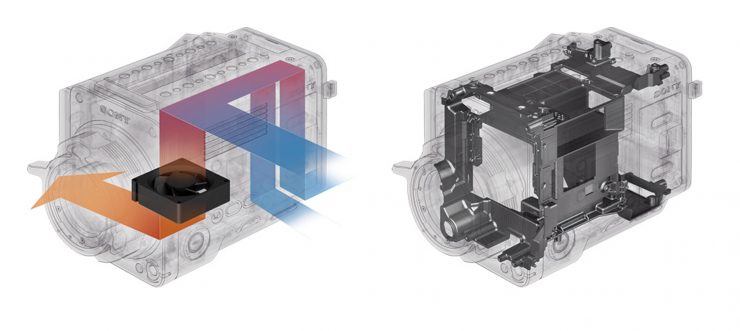
Sony has also claimed to improve the airflow and the cooling system on the new cameras and according to people I have spoken to who have used the camera it seems to run cooler than the original camera. The sensor in VENICE 2 8K also has additional fans on the back of the sensor to reduce temperatures.
The camera also now features an internal scratch mic that can be recorded to two tracks.
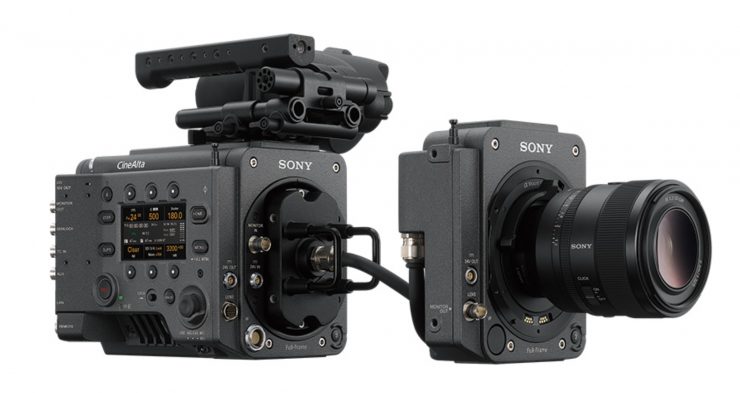
The VENICE 2 6K can be used with the existing VENICE Extension System and a next-generation Extension System for VENICE 2 8K is planned to be released by early 2023.
ND System
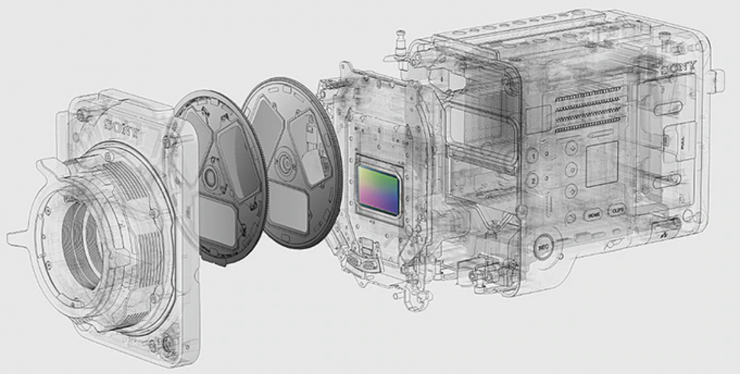
The VENICE 2 keeps the exact same ND system that was used on the original:
Clear, 0.3 (1/2), 0.6 (1/4), 0.9 (1/8), 1.2 (1/16), 1.5 (1/32), 1.8 (1/64) 2.1 (1/128), 2.4 (1/256)
It was perhaps a little interesting to see that Sony didn’t try to implement its electronic variable ND system into the VENICE 2, however, given they are using what is essentially the same body and a lot of similar components from the original VENICE, this doesn’t come as a big surprise.
Lens Mount
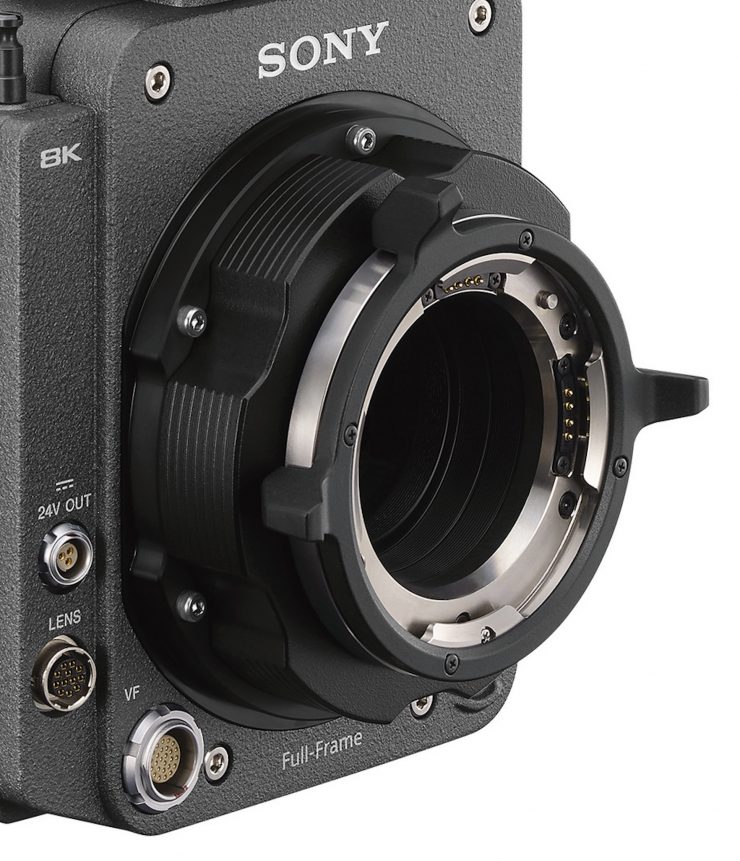
Just like the original camera, the VENICE 2 comes with the industry-standard PL lens mount. It is compatible with all Super35 and full-frame PL lenses, spherical and anamorphic. The lens mount includes contacts that support Cooke/i Technology. Lens information is recorded as metadata frame by frame.
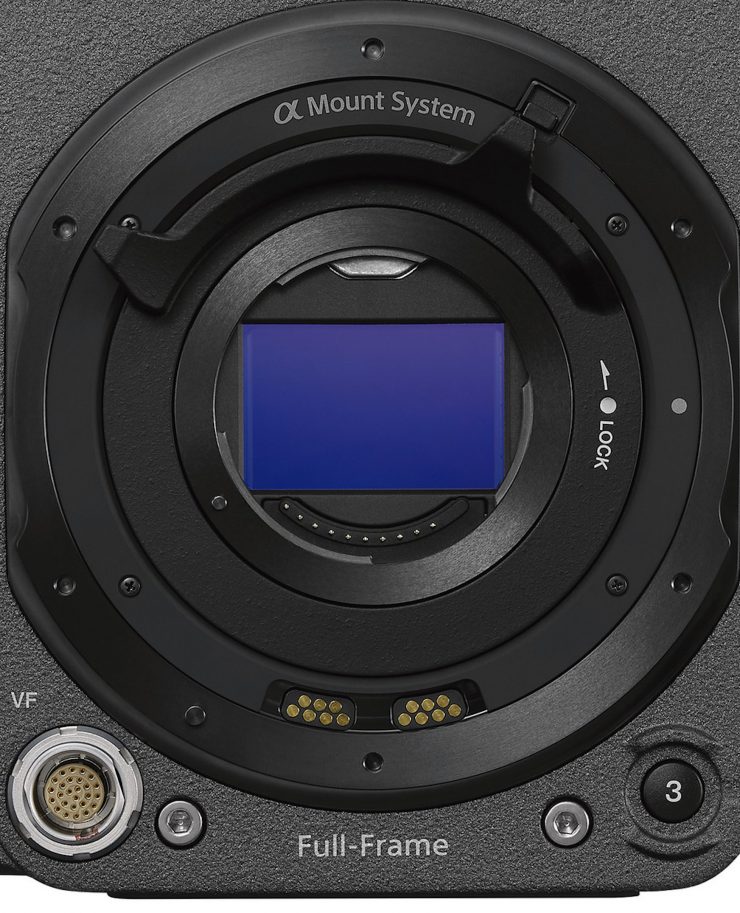
Underneath the PL lens mount is the lever lock type E-mount. This allows you to use a wide array of affordable E-mount lenses and, via third-party adaptors, the world of SLR and rangefinder lenses. Lever lock operation provides added security with large lenses, and in most cases lens support rigs don’t need to be removed when changing lens. Switching from PL Mount to E-mount can be done by simply removing six hex screws, while E-mount lens iris operation is controllable via an assignable button.
It is interesting to see that there doesn’t seem to be an LPL mount available for the VENICE 2.
Inputs & outputs
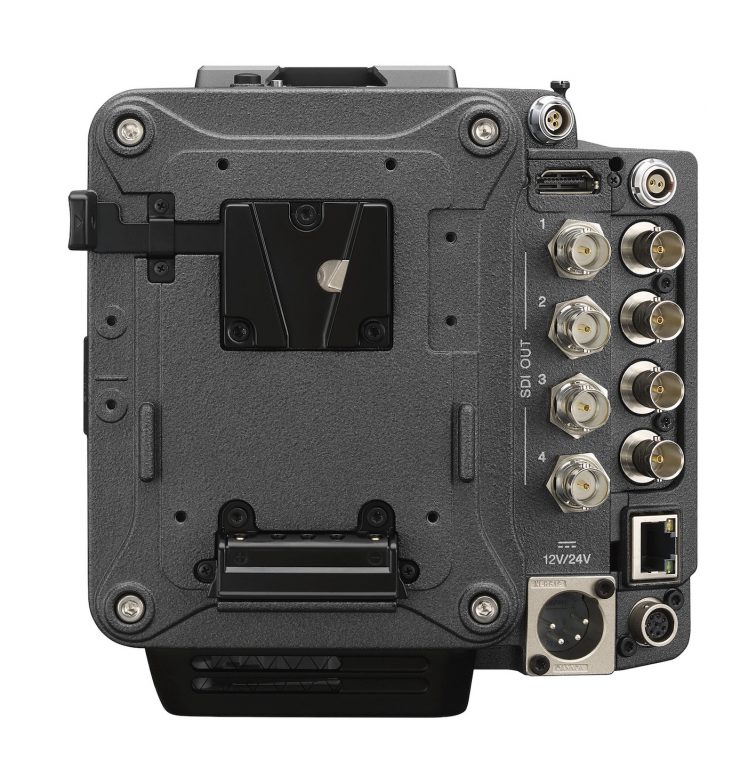
The inputs and outputs of the VENICE 2 remain mostly consistent with that of the original VENICE. The two main differences are that the Hirose 12V output has now been replaced by 2-pin LEMO and the Ethernet port has now been moved to the non-operators side.
The VENICE 2 has the fully inputs and outputs:
DC Input– XLR-type 4pin (male)
Battery DC Input– Square-shaped 5pin connector
DC Output– 12 V: LEMO (2-pin) x 1, 24 V: Fischer 3 pin x 2
SDI Output- BNC x 4, (12G, 3G, 1.5G-SDI)
HD MONI Output– BNC x 1 (1.5G-SDI)
HDMI Output– Type A x 1
VF– LEMO 26pin
Audio Input– XLR-type 5 pin (female) x 1 (LINE / AES/EBU / MIC / MIC + 48 V selectable)
Timecode Input– BNC x 1
Genlock Input– BNC x 1
AUX– LEMO 5 pin (female) x 1 (Timecode Output)
Remote– 8 pin x 1
Lens– 12 pin x 1
Lens Mount Hot Shoe– 4 pin x 2, conforming to Cooke /i Intelligent Electronic Lens System
Network– RJ-45 type x 1, 10BASE-T, 100BASE-TX
USB– USB host, type-A x 1
Headphone Output– Stereo mini jack x 1
Speaker Output– Monoral
Media Type– AXS x 2, SD card slot x 1
.art & LUTS
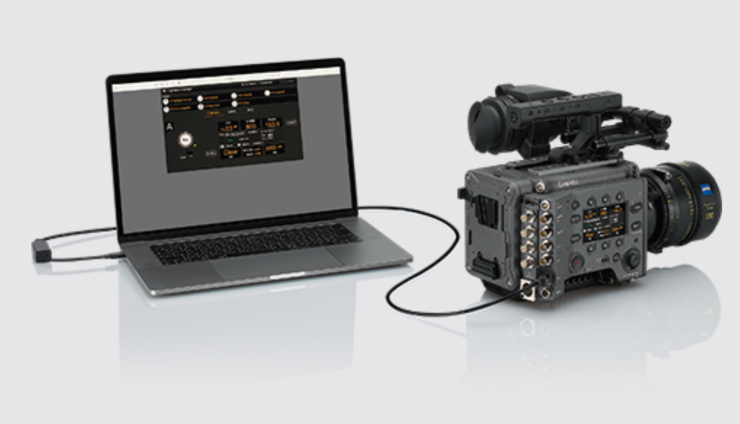
ART (Advanced Rendering Transform) files and LUTs can now be uploaded directly to the camera over Ethernet or WiFi. There is no need to load them up onto an SD card anymore.
For on-set grading, Pomfort is also developing a system to allow live grade control over the camera via Ethernet and WiFi.
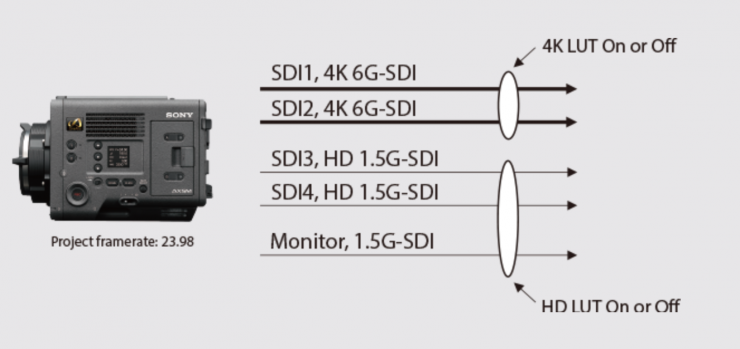
Speaking of LUTS, you can finally output a 4K image with a LUT embedded. This is something that really should have been possible on the original VENICE. Also any EI change you make on the camera will be reflected on the SDIO outputs instead of having to go into a menu and setting it manually.
Menu System
The menu system is fairly similar to the previous VENICE, but it has been tweaked in places and simplified for a better user experience. Previous items that were placed in strange parts of the menus have claimed to be fixed.
New Monitoring Features
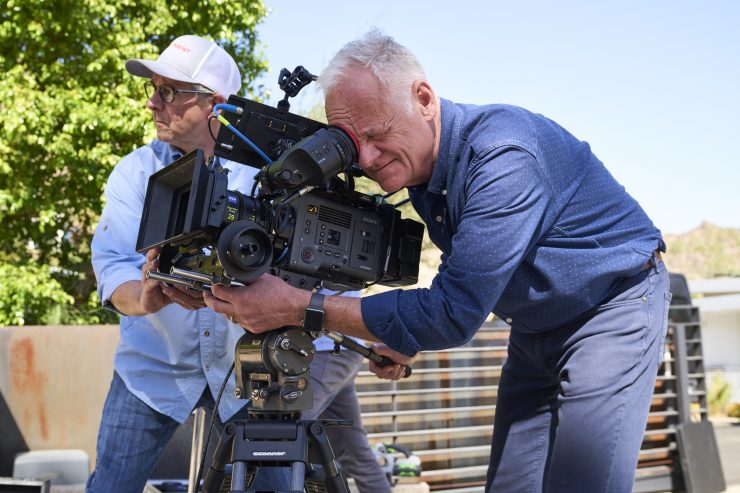
If you happen to be shooting full-frame you don’t have to view a 3:2 image inside a 17:9 or 16:9 frame with black bars on both sides of the image. Sony has implemented a new feature called ‘Zoom to Fit’ which essentially extracts a 17:9 or 16:9 image out of the 3:2.
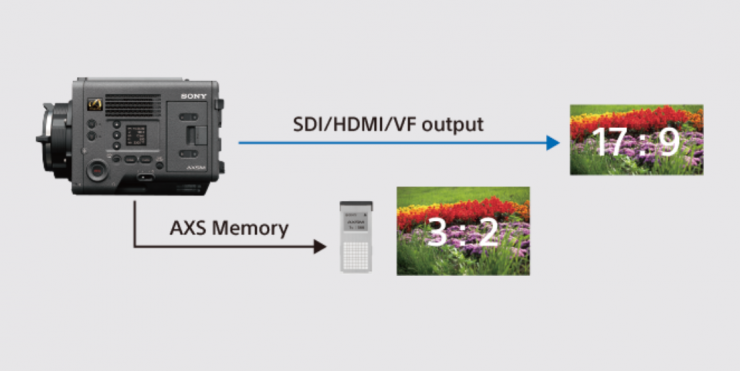
This means you can get a full-screen view in either the EVF or on any of the monitor outputs. That will originally be available when working with spherical lenses. Anamorphic is a little bit more tricky because of the various different squeeze factors, so a Zoom to Fit mode for anamorphic lenses will come at a later date via firmware.
Power
The VENICE 2 8K draws a lot more power than the original VENICE. Sony told me that the camera draws 76W, which is a steep jump over the 60W of the original camera.
Accessories
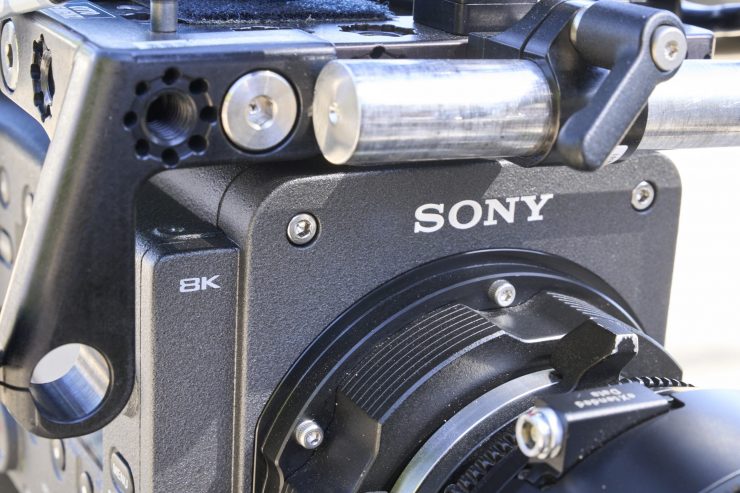
Sony has designed the VENICE 2 so that the majority of the existing accessories, both from Sony and other third parties, will work with the new cameras.
Return of CineAlta?
Sony essentially got rid of the CineAlta naming for their latest digital cinema cameras and instead placed them in what they call the Cinema Line. This Cinema Line consists of the VENICE, FX9, FX6, and FX3, despite the VENICE still wearing the CineAlta badge.
However, if you actually go to the Sony Pro website the only camera listed in the Digital Cinema Cameras section is the VENICE and the discontinued F65, F55, and F5.
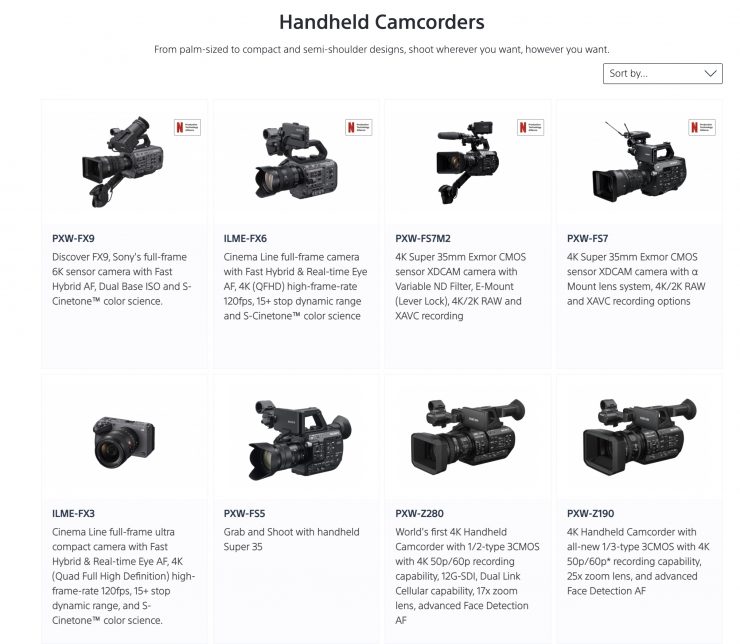
The FX9, FX6, FS7M2, FS7, and FX3 are all grouped into the Handheld Camcorder category along with 1/2-type and 1/3″-type cameras. At least as far as Sony is concerned, they are separating the VENICE and VENICE 2 from other cameras in their range. Look, this doesn’t really mean anything as far as cameras capabilities and performance are concerned, but if you consider that only the VENICE and VENICE 2 are listed in the Digital Cinema Camera section keeping the CineAlta name makes a lot of sense.
With the F5 and F55 now discontinued, there still is a pretty big gap (at least in terms of price) between the VENICE/VENICE 2 and the FX9. That gap is probably something we won’t see filled. Cameras in the $20-$40K price range have all but disappeared from the market.
Thinking within the box
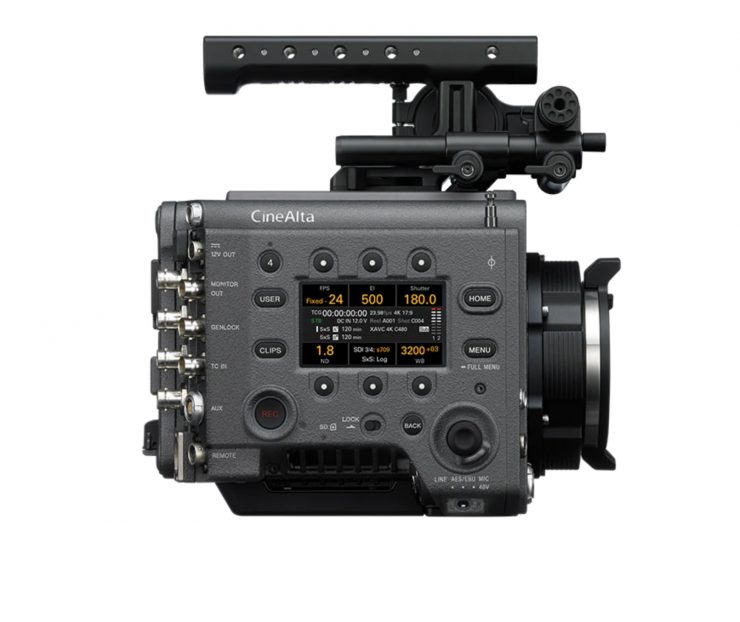
With the VENICE 2 no longer requiring an external recorder, it essentially does become even more of a true ‘box’ style digital cinema camera.
If you look at the digital cinema camera market, almost all of the manufacturers offer a camera in a ‘box’ style. ARRI, RED, Z CAM, Panasonic, and Kinefinity all have cameras that are essentially a box that you then add components to. Canon and Blackmagic don’t make ‘box’ style digital cinema cameras, although you could argue that some of their offerings could be shoehorned into that category.
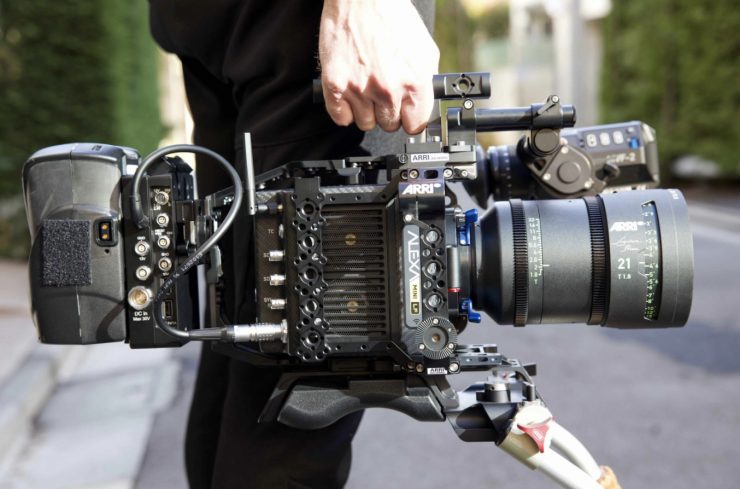
‘Box’ style cameras are popular for numerous reasons, particularly for their ability to be built up or stripped down. Despite this ability, more times than not, they do get built up with numerous components, and depending on the ecosystem, you can end up with a Frankenrig. The best box cameras are the ones that come from manufacturers where they have their own entire ecosystem of accessories and components that work seamlessly and easily with the camera. This is the key to making a camera in this form factor. You need to have all of the components and accessories available that make it work for a variety of shooting scenarios. One of the main reasons that the ARRI Alexa Mini and Mini LF are so popular is because ARRI has an entire ecosystem of components and accessories that are available.
It is no real surprise that Sony is trying to do the exact same thing with the VENICE.
What does this mean for the original VENICE?
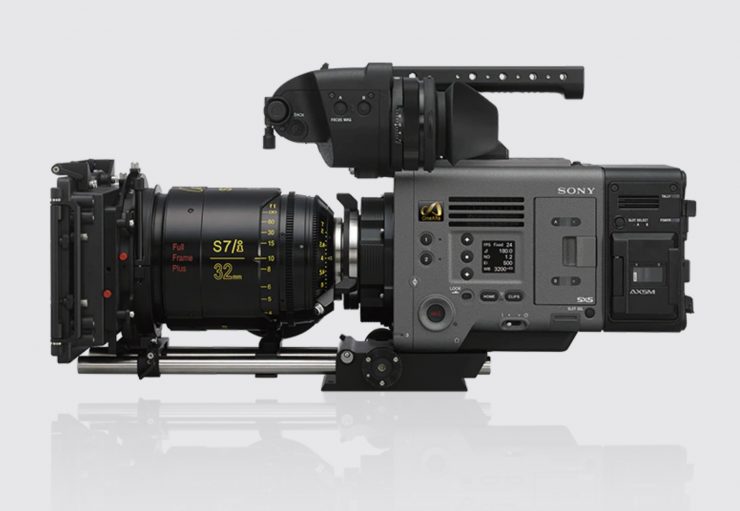
The current VENICE isn’t getting discontinued at this stage and it will remain in the line-up. I wouldn’t imagine it will stay in the line-up for too long given the fact that the VENICE 2 6K is essentially the same camera with different internal recording capabilities.
While Sony told me that there are currently no plans to drop the price of the original VENICE, however, I think that is almost certainly inevitable.
Some existing owners of the VENICE, including rental houses, may be a little upset with this announcement, especially if they had have bought cameras on the premise that they would be able to upgrade them down the track. With the new VENICE 2, rental houses will inevitably have to reduce the rental price of the VENICE, however, this is a four-year-old camera and I am sure most of the rental houses have made their money back, and then some over that time.
Four years is still a pretty good run for a high-end digital cinema camera given how fast technology is changing. Although that’s not to say that the VENICE isn’t still going to be a very capable camera going forward. If you don’t need 8K and you don’t record RAW, then there is probably little reason to even consider upgrading. I think this is also true if you happen to already own an ASX-R7 recorder along with the VENICE.
As I have already mentioned, if you are a current VENICE owner, Sony is going to offer a buy-back program and/or customer loyalty discounts for the VENICE 2 8K and 8K. Just what these deals will be are not yet known. I personally think more camera companies should offer buy-back deals and reward customer loyalty.
Price & Availability
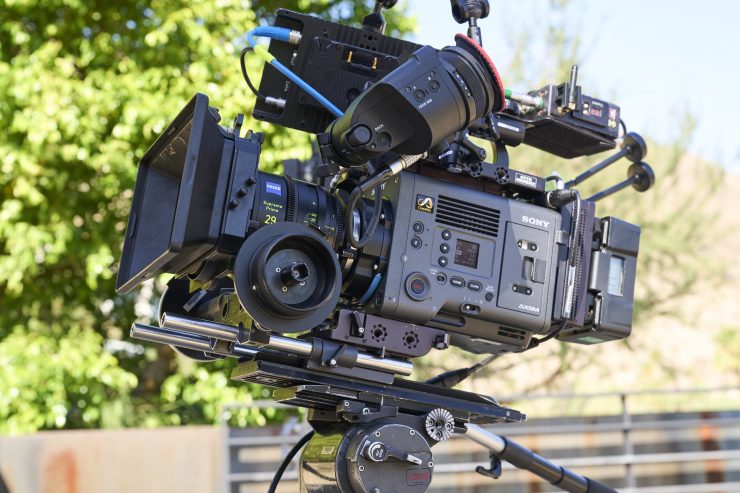
The VENICE 2 8K is scheduled to start shipping in Mid February 2022, while the VENICE 6K won’t be available till Mid March.
The VENICE 2 8K is going to cost more than the original VENICE, but we have not yet been told a price. From what I know, it will be fairly compatible with the price of an ARRI ALEXA Mini LF.
UPDATE: Here are the prices I got from Sony Japan.
- “VENICE 2” 8K (main unit only) around 6,200,000 yen (tax included: around 6,800,000 yen)
- “VENICE 2” 6K (main unit only) around 5,600,000 yen (tax included: around 6,200,000 yen)
- “AXS-A1TS66” around 480,000 yen (tax included: around 528,000 yen)
It is interesting to see that the VENICE 2 8K isn’t that much more than the VENICE 2 6K.
Thoughts
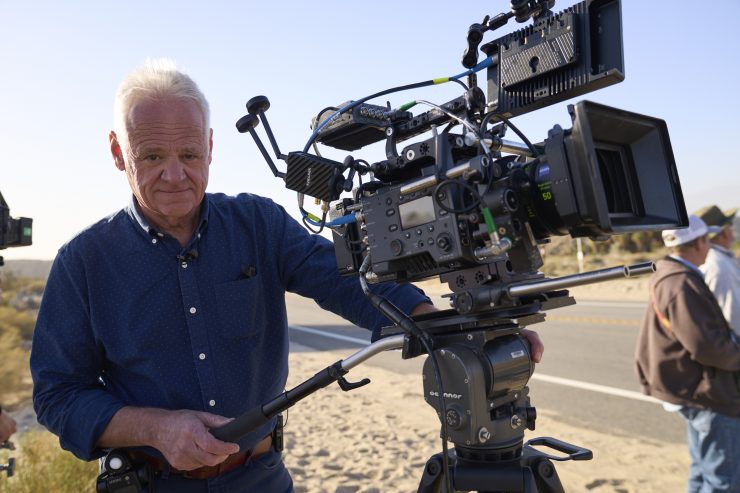
The original VENICE was and continues to be a pretty popular camera. Given the influx of 8K capable cameras that have started to appear, it was not a question of when Sony would bring out an 8K digital cinema camera, but when.
The VENICE 2 builds on the original VENICE, without staying too far off the path. Doing away with the external RAW recorder is nice to see, however, the AXS-R7 wasn’t really that huge and cumbersome to use.
What Sony is trying to make a big point of, is that where the VENICE 2 8K really excels is when it comes to the images it produces. It was interesting to see that they aren’t necessarily making a huge deal about the fact that it is 8K. They are primarily stating that the cameras’ latitude and low light performance are its two biggest selling points.
The VENICE 2 8K looks and appears to be a very capable camera, but original VENICE owners may end up feeling a little short-changed by this announcement. Yes, there will be plenty of people and rental houses who have made a lot of money from their VENICE, but they were sold on a concept of a modular camera where you could upgrade the sensor block down the track. However, if the Sony buyback or customer loyalty discount proves to be pretty decent, then original VENICE owners may not feel so bad.
I personally think that if you can get 4-5 years out of a current digital cinema camera then it is worth the investment. That’s not to say that you can’t get much longer than that, because you certainly can. Just because a new model of a camera appears doesn’t make the old one obsolete. In fact, the original VENICE will almost certainly get a price drop and I am sure rental rates and second-hand prices will also come down from what they currently are.
I like what Sony has done with the VENICE 2 and it is always good for the industry to have more than one player in a segment. Yes, ARRI has dominated the high-end sector for a very long time, but SONY has quietly started to take some of its market share away.
What are your thoughts about the new VENICE 2? Is it a camera you would consider? What do you think about more cameras now getting the ability to record compressed RAW internally? Let us know in the comments section below.



